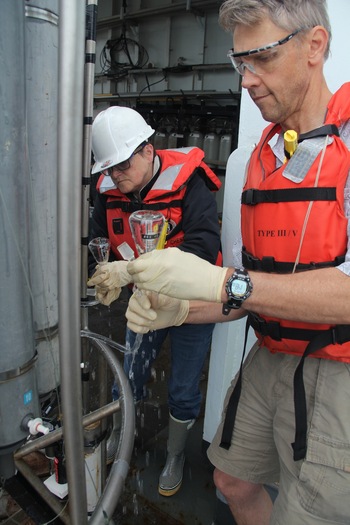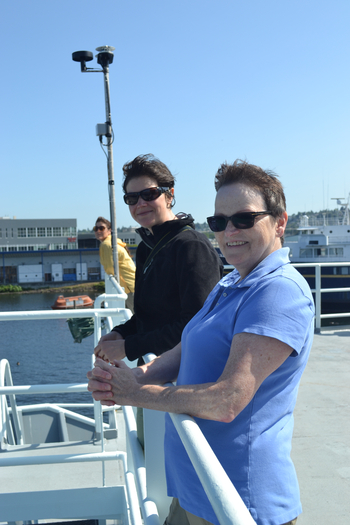July 27, 2013
I have been on board the RV(Research Vessel) Thomas G. Thompson since July 2, 2013, plus or minus a few days in Newport, Oregon. I don’t know how well I can convey the following message, but I will try: 25 DAYS AT SEA FEELS LIKE AT LEAST TWO AND A HALF MONTHS ON LAND!!!!! No wonder Co-Chief Scientist Debbie Kelly questioned my eagerness to be included on the entire VISIONS13 voyage from July 2 to the end of August.
I have learned quite a bit. There are lectures almost every night. I have learned about Hydrothermal Vent Systems, Submarine Volcanoes and the various forms of lava that they spew. I have learned about CTD casts, as well. A CTD rosette is a device that can collect and analyze water samples throughout the water column. The water column is simply any column of water from the ocean floor to the surface. Sometimes scientists want to sample a particular water column in an area around a hydrothermal vent system or perhaps around a submarine volcano.
A major portion of this leg of the VISIONS13 expedition is dedicated to laying cable on the sea floor with an ROV(remotely operated vehicle)known as ROPOS, from the Canadian Submersible Scientific Facility. This cable contains both fiber optics as well as electrical power. These cables will allow for the permanent installation of scientific instruments on the ocean floor. The weather for the last week has been quite calm so the ROV has been diving almost continuously. It only comes up long enough to go through its preparations required for a subsequent dive. We use a logging system called IRLS(Integrated Real-time Logging System) that records live video and still camera shots of the dive. We add narration and the system keeps track of the location and position. The system keeps track of all the events that are taking place so we have a complete record of everything. I have learned about short period seismometers, and Bottom Pressure Tilt Plates, and Thermistor Arrays as well. Also included is an instrument for measuring temperature and salt content of Hydrothermal Vent fluids. All of these instruments provide pieces of information about the ocean to the scientific community, and ultimately the general public as well.
I know what the scope and purpose of the Regional Scale Nodes project of the Ocean Observatories Initiative is. It will change the face of oceanographic research. This system, in which I have played a very small part, will make it so that unprecedented electrical power and communications bandwidth will be delivered to entire ocean volumes that can dramatically accelerate rates of technological adaptation and scientific innovation focusing on our ultimate planetary life support system, the Ocean.
I am returning to land in early August, after Leg 3. I am thankful to have been a part of this expedition, VISIONS13. I am equally thankful to be returning to land and my home and family
July 16, 2013
I have just spent 2 weeks at sea with VISIONS’13. I have about 3 weeks left in this journey. I had no idea what to expect. I had been given an agenda, or schedule of course, and knew we were going to be “laying cable, doing CTD casts, deploying instruments and J Boxes, and observing bubble plumes and black smokers.” I now have a pretty good idea of what each step in this process is about and how it all fits together.
Speaking of all fitting together, all the planning that went into this ~60 day adventure is all dependent upon many conditions that are not directly under the control of the Chief Scientists and engineers who planned this event. The weather must cooperate, the remotely operated vehicle (ROV) must be functioning correctly, the equipment on the ship must be functioning correctly. All of these have been tested, and retested, but one never knows.
What I have witnessed over the course of the last two weeks has been the result of the most cooperative effort I have witnessed. The ship personnel, the ROV crew, the scientists, engineers, students and educators, all are cogs in this well oiled machine that is called oceanographic research. All must be prepared for a multitude of situations which means that all plans must be ultimately flexible, or essentially one must be ready for a multitude of scenarios to be employed at any minute. To put in into broader terms, one must be ready to fly by the seat of one’s pants, with a much prescribed plan of action, at any minute, depending upon weather, or whatever else happens to be occurring shipboard at the time.
These plans do not occur by happenstance. The two chief scientists, John Delaney and Deborah Kelley do an incredible job making all this work. There are many levels of organization that must be accounted for. They have done an excellent job trying to accommodate all of the various interests of all the scientists, engineers, researchers and students who are participating in the expedition.
I have discovered that time or even the day does not matter; night time is just as good a time to work as the daytime, Saturday and Sunday are just another day. Everything can be happening at once, or all can be waiting for the conditions to be appropriate for things to happen.
I am extremely grateful to be participating in this expedition and will be relaying and utilizing these experiences with my students and colleagues at Grays Harbor College and the students I work with at Stevens Elementary School.




